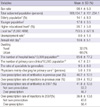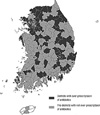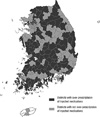1. Choi JH. Recent evidences of sepsis treatment. Infect Chemother. 2008. 40:67–75.
2. Yum HY. Antibiotics for bacterial pneumonia in children. Korean J Pediatr. 2009. 52:283–288.
3. Del Mar C. Prescribing antibiotics in primary care. BMJ. 2007. 335:407–408.
4. Tan T, Little P, Stokes T. Guideline Development Group. Antibiotic prescribing for self limiting respiratory tract infections in primary care: summary of NICE guidance. BMJ. 2008. 337:a437.
5. Pradier C, Rotily M, Cavailler P, Haas H, Pesce A, Dellamonica P, Obadia Y. Factors related to the prescription of antibiotics for young children with viral pharyngitis by general practitioners and paediatricians in southeastern France. Eur J Clin Microbiol Infect Dis. 1999. 18:510–514.
6. Centers for Disease Control and Prevention (CDC). HIV infection among injection-drug users - 34 states, 2004-2007. MMWR Morb Mortal Wkly Rep. 2009. 58:1291–1295.
7. Lee SW, Kim SY, Kim JK. Seropositivity of anti-HCV in intravenous drug abusers. J Korean Acad Fam Med. 1997. 18:1508–1518.
8. Huang N, Chou YJ, Chang HJ, Ho M, Morlock L. Antibiotic prescribing by ambulatory care physicians for adults with nasopharyngitis, URIs, and acute bronchitis in Taiwan: a multi-level modeling approach. Fam Pract. 2005. 22:160–167.
9. Akkerman AE, van der Wouden JC, Kuyvenhoven MM, Dieleman JP, Verheij TJ. Antibiotic prescribing for respiratory tract infections in Dutch primary care in relation to patient age and clinical entities. J Antimicrob Chemother. 2004. 54:1116–1121.
10. Majeed A, Moser K. Age- and sex-specific antibiotic prescribing patterns in general practice in England and Wales in 1996. Br J Gen Pract. 1999. 49:735–736.
11. Cadieux G, Tamblyn R, Dauphinee D, Libman M. Predictors of inappropriate antibiotic prescribing among primary care physicians. CMAJ. 2007. 177:877–883.
12. Kozyrskyj AL, Dahl ME, Chateau DG, Mazowita GB, Klassen TP, Law BJ. Evidence-based prescribing of antibiotics for children: role of socioeconomic status and physician characteristics. CMAJ. 2004. 171:139–145.
13. Kuyvenhoven M, de Melker R, van der Velden K. Prescription of antibiotics and prescribers' characteristics. A study into prescription of antibiotics in upper respiratory tract infections in general practice. Fam Pract. 1993. 10:366–370.
14. Hwang JH, Kim DS, Lee SI, Hwang JI. Relationship between physician characteristics and their injection use in Korea. Int J Qual Health Care. 2007. 19:309–316.
15. Jo CI, Lim JY, Soo YL. The effect of the degree of competition of the hospital market regions on clinic's rate of antibiotics prescription. KDI J Econ Policy. 2008. 30:132–155.
16. Parchman ML. Small area variation analysis: a tool for primary care research. Fam Med. 1995. 27:272–276.
17. Cho WH, Lee SH, Park EC, Sohn MS, Kim SR. An analysis of small area variations of hospital services utilization in Korea. Korean J Prev Med. 1994. 27:609–626.
18. Thrane N, Olesen C, Schønheyder HC, Sørensen HT. Socioeconomic factors and prescription of antibiotics in 0- to 2-year-old Danish children. J Antimicrob Chemother. 2003. 51:683–689.
19. Britten N, Ukoumunne O. The influence of patients' hopes of receiving a prescription on doctors' perceptions and the decision to prescribe: a questionnaire survey. BMJ. 1997. 315:1506–1510.
20. Rutschmann OT, Domino ME. Antibiotics for upper respiratory tract infections in ambulatory practice in the United States, 1997-1999: does physician specialty matter? J Am Board Fam Pract. 2004. 17:196–200.
21. Chonmaitree T, Revai K, Grady JJ, Clos A, Patel JA, Nair S, Fan J, Henrickson KJ. Viral upper respiratory tract infection and otitis media complication in young children. Clin Infect Dis. 2008. 46:815–823.
22. Kristo A, Uhari M. Timing of rhinosinusitis complications in children. Pediatr Infect Dis J. 2009. 28:769–771.
23. Mainous AG 3rd, Hueston WJ, Love MM. Antibiotics for colds in children: who are the high prescribers? Arch Pediatr Adolesc Med. 1998. 152:349–352.
24. Janjua NZ, Hutin YJ, Akhtar S, Ahmad K. Population beliefs about the efficacy of injections in Pakistan's Sindh province. Public Health. 2006. 120:824–833.
25. Kim NS, Jang SN, Jang SM. Factors influencing antibiotics prescribing of primary health physicians in acute upper respiratory infections. J Prev Med Public Health. 2005. 38:1–8.
26. Wang KY, Seed P, Schofield P, Ibrahim S, Ashworth M. Which practices are high antibiotic prescribers? A cross-sectional analysis. Br J Gen Pract. 2009. 59:e315–e320.
27. Welschen I, Kuyvenhoven MM, Hoes AW, Verheij TJ. Effectiveness of a multiple intervention to reduce antibiotic prescribing for respiratory tract symptoms in primary care: randomised controlled trial. BMJ. 2004. 329:431.
28. Altiner A, Brockmann S, Sielk M, Wilm S, Wegscheider K, Abholz HH. Reducing antibiotic prescriptions for acute cough by motivating GPs to change their attitudes to communication and empowering patients: a cluster-randomized intervention study. J Antimicrob Chemother. 2007. 60:638–644.





 PDF
PDF ePub
ePub Citation
Citation Print
Print







 XML Download
XML Download